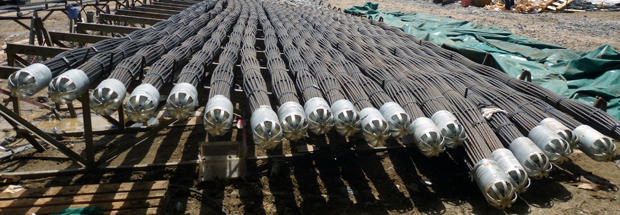BBR ground anchors
One of the early civil engineering applications of BBR prestressing technology was for anchoring structures into the ground and for stabilizing slopes using ground anchors. Since then, BBR ground anchors has evolved significantly and our latest milestone – the CONA® CMG strand ground anchor – has benefitted a wide range of customers. PT bars, soil nails, rock bolts and micropiles complete the range.
 |
Function and range
The function of a ground anchor is to provide anchorage of a structure to a solid substrate - either through active pre-tensioning of the ground anchor to the anchorage zone, or through passive anchorage via low lock–off loads (e.g. rock bolts). The main components of a ground anchor are the bonded length, free length and the anchorage. Specification and detailing of each is dependent on the ground conditions, soil type, durability and geometry requirements, design loads and site constraints.
CONA CMG anchors are currently available in capacities from 260 kN to 25,390 kN ultimate breaking load (from 1 to 91 strands), and in a wide range of options with regard to corrosion protection and geometry.
Temporary anchors
When the service life of the anchor is limited to less than two years, it may be detailed as a temporary anchor - depending on the site conditions, consequence of failure and risk of corrosion. Temporary anchors have reduced corrosion protection, simpler detailing and can be specified so that they may be removed after they are no longer needed with careful detailing of the tendon and anchorage. Temporary anchors generally have a bonded length of between 4 and 12 meters with bare strands and grouted in place. The free length is generally more than 7 m in length, where the strand is usually individually greased and sheathed, or bare assembled in a smooth sleeve.
Removable anchors are specified when temporary anchors cannot be left de-stressed in the ground. This is most commonly due to easement or environmental reasons.
Permanent anchors
Permanent anchors are designed with very high levels of corrosion protection, which sets them apart from their temporary counterparts. They are entirely encapsulated in a duct – this is smooth in the free length and corrugated in the fixed length. The tensile elements are individually greased and PE-sheathed in the unbonded length and bare in the bonded length. Inner and outer grout filling ensures highest corrosion protection for a 100+ year design life.
Similar to temporary anchors, permanent anchors should have a bonded length of typically between 4 and 12 meters with bare strands arranged in a bulb shape and grouted in place. The free length should be longer than 7 m.
In fact, BBR anchors hold the record for the longest permanent ground anchor ever installed at over 142 m in length!
A key consideration in many projects is the ability to check, test, or re-stress anchors during the service life of the structure. Depending on the detailing of the anchor head, the free length of the anchors allow them to be check-stressed in the future as well as re- tensioned if required. Re-stressable and control anchor heads are available for all sizes of the CONA CMG system.
Service offerings
 |
BBR PT specialists are available at any stage of your project to assist in the selection of the anchorage system. Early consultation with a BBR representative will lead to a more effective design, as they can provide guidance on the many options and configurations available for the CONA CMG technology or any other ground anchor system - and will help you specify the best anchorages for your project. Services include:
- Consultancy services to contractors and design consultants
- Pre-assemby and supply to site
- Installation, stressing and grouting operations
- Monitoring, checking and re-stressing
- De-tensioning and removal of anchors